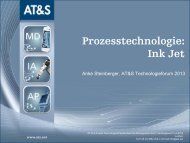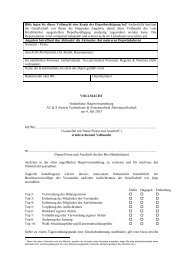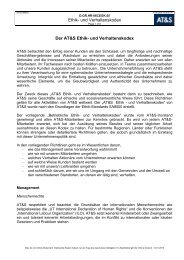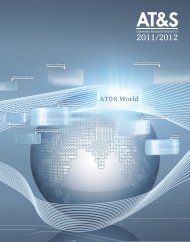AT&S World
AT&S World
AT&S World
You also want an ePaper? Increase the reach of your titles
YUMPU automatically turns print PDFs into web optimized ePapers that Google loves.
Consolidated Financial Statements as of 31 March 2011<br />
70<br />
II. Risk Report<br />
Financial risks<br />
Risk management of financial risks is carried out by a central<br />
treasury department (Group Treasury) under policies approved<br />
by the Management Board. Responsibilities, authorisations and<br />
limits are governed by internal guidelines. Group Treasury identifies,<br />
evaluates and hedges financial risks in close cooperation<br />
with the Group’s operative units. The Board provides written<br />
principles for overall risk management, as well as written policies<br />
covering specific areas, such as foreign exchange risk, interest<br />
rate risk, credit risk, use of derivative financial instruments<br />
and non-derivative financial instruments, and investing excess<br />
liquidity.<br />
The risk management of financial risks is incorporated in the<br />
group-wide risk management and thus part of the timely risk<br />
reporting to executive employees, Management and Supervisory<br />
Board.<br />
Liquidity risk<br />
At the balance sheet date, the Group has liquidity reserves in<br />
the amount of EUR 118.8 million, EUR 18.2 million of which is<br />
accounted for by cash (equivalents) and securities held for trading<br />
and available-for-sale securities, and EUR 100.6 million by<br />
available unused credit facilities. Thus, the liquidity reserves<br />
increased by EUR 31.5 million year-on-year. In the past financial<br />
year, the secured credit lines in particular were raised from<br />
EUR 167.7 million to EUR 243.7 million, and thus the unused<br />
committed credit lines amount to EUR 88.4 million.<br />
The Company is authorized, subject to the approval of the Supervisory<br />
Board, to issue up to 12,950,000 new shares from authorized<br />
capital, as well as convertible bonds in a total nominal<br />
amount of up to TEUR 100,000, and to sell treasury shares (at the<br />
balance sheet date the Group holds 2,577,412 treasury shares).<br />
With respect to a detailed explanation of the options regarding<br />
capital measures, reference is made to Note 22 “Share capital”.<br />
The Group has a clearly positive operating cash flow. The net<br />
cash flow from operating activities for the financial year 2010/11<br />
amounts to EUR 70.7 million (2009/10: EUR 47.0 million). Thus,<br />
most of the investments made in the past financial year could<br />
be financed from the operating cash flow.<br />
With regard to liquidity risks, reference is also made to the detailed<br />
disclosures in Note 16 “Financial liabilities”.<br />
Financial market risks<br />
Detailed information on market risks and derivative financial instruments<br />
is contained in Note I.B.l. “Summary of significant accounting<br />
policies: Derivative financial instruments” and in Note<br />
19 “Derivative financial instruments”. The Group uses derivative<br />
financial instruments, such as forward contracts, options and<br />
swaps, exclusively for hedging purposes.<br />
Interest rate risk<br />
Minor interest rate risks on the assets side of the balance sheet<br />
relate to investments in securities. Most of the other liquid resources<br />
are invested short-term and all securities are available<br />
for sale, Reference is made to Note 13 “Financial assets” and Note<br />
14 “Cash and cash equivalents”.<br />
On the liabilities side, 83% of the borrowings are subject to fixed<br />
interest rates, taking into account interest rate hedging instruments,<br />
and most of the remaining variable interest rate loans<br />
(17%) have maturities of less than one year. Reference is made<br />
to Note 16 “Financial liabilities”.<br />
Currency risk<br />
Transaction, translation and economic risk are constantly<br />
monitored to guard against currency risk. Transaction risk is<br />
mostly internally managed by closing positions (netting), in some<br />
cases derivative financial instruments are used to hedge open<br />
positions.

















